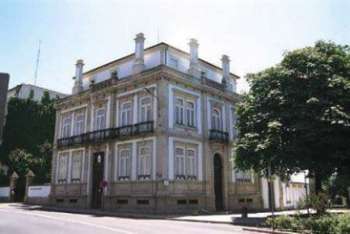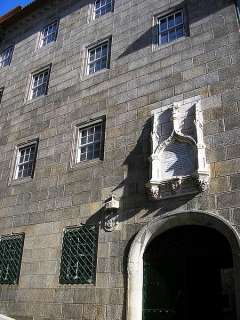|
|
| |
PORTUGAL
PORTO MUSEUMS
Soares dos Reis National MuseumSoares dos Reis National Museum, located in the ancient Carrancas Palace, in Porto, Portugal, is one of the most renowned Portuguese museums. Founded in 1833 it is Portugals first national museum. It displays one of the finest collections of Portuguese art, in particular a gallery of works by Portuguese sculptor António Soares dos Reis, after whom the museum is named.
The museum has a vast collection mainly focused on Portuguese art of the 19th and 20th centuries, including painting, sculpture, furniture, metalwork and ceramics. Artists represented include painters Domingos Sequeira, Vieira Portuense, Augusto Roquemont, Miguel Ângelo Lupi, António Carvalho de Silva Porto, Marques de Oliveira, Henrique Pousão, Aurélia de Souza, Dordio Gomes, Júlio Resende and sculptors Soares do Reis, Augusto Santo, António Teixeira Lopes, Rodolfo Pinto do Couto and many others.
For more information and enquiries please contact Soares dos Reis National Museum,
Rua D. Manuel II,
4050-342, Porto, Portugal, Tel: +351 22 339 3770, E-mail: mnsr@ipmuseus.pt
 The main facade of the Soares dos Reis National Museum Photograph taken by Jose Goncalves
Museu Militar do PortoThe Museu Militar do Porto is a pertaining institution to the Portuguese Army, dedicated for the preservation of military history, located in Porto, Portugal. The collection of miniature figures, displaying the evolution of soldiers since pre-history till present day is the Military Museums main attraction. This collection is represented by 16,000 miniatures. The Museum also holds a room dedicated to the Revolution of January 31, 1891, the first attempt to establish a Republic in Portugal. The museum collection also includes several cannons and combat vehicles, from the 15th to the 20th centuries, located in the Park of Heavy Weapons and the Pavilion of Weapons. The museum also contains a small library open to the public.
For more information and enquiries please contact Museu Militar do Porto, Rua do Heroísmo 329, 4300, Porto, Portugal, Tel: +351 225 365 514, E-mail: mmporto@adsl.tvtel.pt
 View seen from the side of the Museu Militar do Porto
The Serralves MuseumThe Serralves Museum is located is located in the Quinta de Serralves, a large property close to the center of Porto that includes a main house built in the 1930s for the Count of Vizela.
Today it is owned by the Serralves Foundation, the house was built by the second Conde de Prado, Carlos Alberto Cabral and designed by the architect José Marques da Silva. It is a unique example of Streamline Moderne architecture in Portugal. It is the first large-scale contemporary art museum in Portugal. The landscaped gardens designed by Siza Vieira, on the approximately 18 hectars of land, preserved the most important species already existing on the site. The public access to the Museum's ground is made at the highest level of the terrain through an opening in the existing wall that surrounds the property.
For more information and enquiries please contact Rua Dom Joao de Castro 210,
4150-417, Porto,
Portugal, Tel: +351 808 200 543 / +351 226 156 500, E-mail: informacoes@serralves.pt
 The Serralves Museum, view from the gardens Copyright © Rei-artur
Arqueossítio da Rua de D. HugoThe Arqueossítio da Rua de D. Hugo is a museum and historic site in the city of Porto in Portugal. It is located at number 5 Rua de Dom Hugo, near the Cathedral of Porto. It is to date the oldest of human occupations in the city of Porti. The original house was Gothic but was destroyed. It has, however, taken advantage of its original walls for the construction of a new building. In the 1980 excavations were made that uncovered traces of a much earlier occupation dating from the fourth century BC to the present. Here were identified traces of a proto-historic fort. Since 1993, it has been the seat of the Northern Region Division of the Order of Architects.
For more information and enquiries please contact Rua Dom Hugo, 3-5, 4050-305, Porto, Portugal, Tel: +351 222 003 689 / +351 222 053 644, E-mail: museuguerrajunqueiro@cm-porto.pt
 Arqueossítio da Rua de D. Hugo Early city walls, originaly built by the Romans Photograph by Manuel de Sousa
Casa do Infante The Casa do Infante (Prince's House), also known as the Alfândega Velha (Old Customs House) is a historical house in the city of Porto, in Portugal. The house was originally built in the 14th century as customs and mint, although its present condition derives mostly from a remodelling carried out in the 17th century. The Casa do Infante is located in the historical centre of Porto, designated World Heritage Site by UNESCO. Archaeological excavations revealed that the building was large and had two high towers linked by a courtyard. Starting in the 15th century, the customs house has undergone several expansions and remodellings that have greatly altered its original structure. Besides the mediaeval findings, the archaeologists found the vestiges of a large Roman building, including remains of mosaic pavement that can now the seen inside. The Casa do Infante now houses an exhibition about the history of Porto (including a scale model of the city in the Middle Ages) as well as the Municipal Archive.
For more information and enquiries please contact R. da Alfândega 10, 4050 Porto, Portugal, Tel: +351 226 081 000, E-mail: dmarquivos@cm-porto.pt
 Main façade of the Casa do Infante with inscription commemorating Prince Henry's birth
|
|
|
|
|